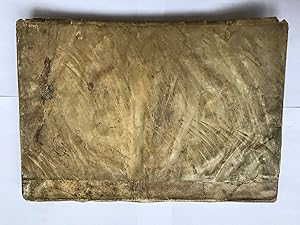Beschreibung
FIRST ILLUSTRATED EDITION OF ONE OF THE MOST CELEBRATED EARLY GUIDES OF ROME EMBELLISHED BY SEVERAL LARGE AND FINE ENGRAVINGS. MARLIANI, Bartolomeo. Urbis Romae Topographia. Rome, in aedibus Valerij dorici & Aloisij fratris,., 1544. £9,750 FIRST ILLUSTRATED EDITION. Folio, ff. 6, pp. 122 [2], A6, A-B4, C-L6. Italic letter, some Roman and Greek. T-p without ornamentation, woodcut initials. 23 fine woodcut illustrations, including a folding double-page engraved map of Rome signed by the calligrapher Giovanni Battista Palatino (Frutaz 12); very large woodcut printer s device (Pegasus) on recto of final leaf with register and imprint date. First issue, which shows the text of the privilege from Pope Paul III. Small hole due to the moulding of a little area of the upper margins of the first three initial leaves. Extensive waterstaining affecting the book throughout, along gutters and foot margins. Light soiling, or spotting, and thumb marking to margins of some pages. Folding plate with the plan of Rome somewhat worn, with some parts partially detaching. In contemporary limp vellum, missing ties, cover edges slightly ragged. A good well-margined copy on thick paper, despite the waterstains. The FIRST illustrated edition of this important guide to Rome, dedicated to Francis I. The text, first published in 1534 by Antonio Blado with a dedication by Rabelais, was substantially amended and enriched with woodcut plans, views, and sculptures for the present edition. Born towards the end of C15th to a noble Milanese family, Bartolomeo Marliani dedicated his life to the study of Roman archaeology. This work was the pre-eminent account of the antiquities of classical Rome of his day, many of which were to suffer subsequent alteration or disappearance. This edition is one of the masterpieces of Renaissance classical architecture and has remained justly sought after throughout four and a half centuries. The enduring importance of the work is that it tells us what the city was like before many of its ancient ruins were altered, incorporated or swept away in the great building activities of the later C16th and C17th . Marliani s approach to the archeology of Rome differs considerably from that of his predecessors, especially Giacomo Mazzocchi, in that he gives far more prominence to architectural and sculptural detail than to inscriptions, which had almost solely occupied earlier archaeologists. Illustrations include a map of Rome, the mythological founders of the city Romulus, and his brother Remus with the she Wolf, the Laocoon, the Circus Maximus, the Pyramid, the Pantheon, and the Obelisk. The depiction of the statue of Laocoon is one of the earliest; Marliani had been present in Rome for the discovery of the statue in 1520. BM STC It. p.418; Fowler p.189; Olschki 17512; Brunet III 1437-8 Edition ornée de bonne gravures sur bois….Elle est rare, assez recherchée, et néanmois à bas prix . Mortimer, Harvard C16 It. 284 (with 4 reproductions); Censimento 16 CNCE 34273; Culot, Bozerian roulettes 19, 42, palettes 3, 12, signatures 1; Adams M-610; Berlin Kat. 1831; Schudt 605. Bestandsnummer des Verkäufers ABE-1519749409314
Verkäufer kontaktieren
Diesen Artikel melden
![]()




